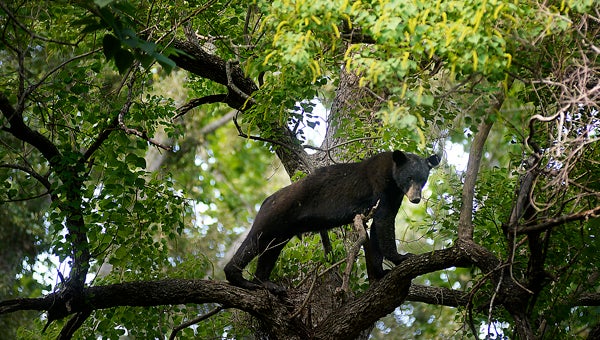Louisiana Commission starts process of creating a bear season
Published 4:50 pm Friday, October 13, 2023

- A black bear was spotted in a Ridgecrest backyard in 2015. Louisiana Wildlife and Fisheries responded and was able to get the bear into a trap. The juvenile male bear was evaluated and fitted with a GPS tracking collar before being release back into the wild. In case of a black bear sighting call Louisiana Wildlife and Fisheries toll free at 1-800-422-2511. (Sam Gause / Natchez Democrat)
|
Getting your Trinity Audio player ready...
|
BATON ROUGE — A modern black bear hunting season could be on the way for Louisiana. State Senator Stewart Cathey made an announcement that the commission was moving forward with creating a modern hunting season on October 5.
Louisiana Department of Wildlife and Fisheries Commissioners met for over 6 hours on October 5 to discuss the black bear program, alligator program, civil restitution changes, menhaden regulations and other topics. The black bear program update and public comments supporting a new bear season lasted about half an hour.
Louisiana Commissioner Joe McPherson said the commission has requested a Notice of Intent to be drafted by the Louisiana Black Bear program to start the process of creating a black bear season. It is the first step to a long journey to restore black bear hunting in Louisiana. Program Manager John Hanks said they will be careful in their planning.
“We know we can have conservative harvest in a limited area,” Hanks said. “This will be a gradual phase, we will be conservative. Not everyone will get to shoot the bear tearing up their deer feeder.”
Cathey started the process of creating a bear season by writing bipartisan supported legislation to create one. McPherson asked him to allow the commission to undertake creating the season. He obliged and last Friday his work came to fruition.
“Thank you for keeping your word. It was nice you did that,” Cathey said. “The one request I do have is that hunters and fishermen are the greatest conservationists of the world. Look at alligators on the brink of extension, we don’t have a problem with too few alligators now. .We should be able to do the same thing with bears. They don’t have a predator in the wild. We can keep them out of deer feeders. When we work to create the season, lets make the tags transferable. Allow a landowner to transfer a tag to someone else. Allow them to sell the tag to recoup the money. Thank you.”
A strong population
Black bears are native to Louisiana but by the 1900s had seen a sharp decline due to lack of quality habitat and over harvest by commercial hunting. As a result, the bears dwindled to a population estimate of 442 and were listed as threatened by the United States Fish and Wildlife Service in 1992.
Louisiana studied bears in the four subpopulations found in the Tensas River region, Atchafalaya Basin, Coastal parishes and the Repat area which includes Concordia and Avoyelles parish. By 2014, 675 bears were counted and they were delisted as threatened by the USFWS in 2016.
Hanks said they entered a five year surveillance where hair snare studies, collaring, den surveys and other projects counted a population of 1,212 bears. He clarified the number is about 80 to 90 percent of Louisiana’s black bear population and grew due to better methods of counting the bears. All four of Louisiana’s sub populations are either stable or growing.
A landowner in Madison and Tensas Parish said he counted eight bears in his pecan orchard last year, found two bear skulls on his property and saw a flock of turkeys and a bear while deer hunting this weekend. All things he never thought he would see in 1985. He was in support of the season.
Robert Kennedy III, Chairman of the Safari Club International Acadiana Chapter, made a public comment in support of the LDWF creating an NOI for a new black bear season.
“We have a bear population that is healthy and strong,” Kennedy III said. “A season would be a wise move. We support any efforts to move toward a season.”
Hungry bears
Bears can cause a scare when they enter urban areas and they can cause crop damage to agriculture. Hanks pointed out that while bears do cause problems to crops and native plant communities, they do not reproduce as quickly or as many offspring like deer and wild hogs do.
One commissioner asked if bears can eat fawns in Louisiana. Hanks told the commission while bears could eat a fawn, they are opportunistic omnivores and lazy.
“He will stay there at a deer feeder as long as it has food in it,” Hanks said. “They are not actively seeking fawns. Bears in places up north need food sources because it is so cold. But here they have enough food sources. They can move around and eat during the winter. Abundance of food here is either natural, agricultural or put there by man. Bears do eat small hogs, turkeys and fawns but it is likely opportunistically.”
LDWF commissioners will meet on November 3 in Baton Rouge where they will likely announce a Notice of Intent to create a modern bear season.






